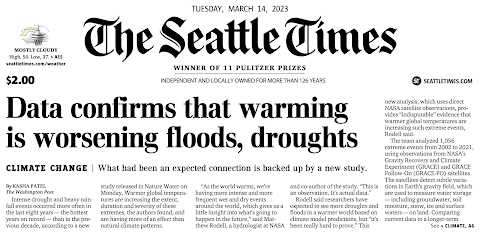Whether you are a climate activist, a governmental official, or a citizen hoping to be well-informed on climate issues, getting accurate and reliable climate information is important.
Unfortunately, the Seattle Times continues to provide unfactual information, with screaming headlines and stories that can easily be shown to be incorrect.
This disappointing behavior by Seattle's only newspaper was obvious on Tuesday (see below).
A blaring, big-type headline heralded that "DATA CONFIRMS THAT WARMING IS WORSENING FLOODS, DROUGHT".
And in the subtitle, they double down: "WHAT HAD BEEN AN EXPECTED CONNECTION IS BACKED UP BY A NEW STUDY"
As I will demonstrate below, these claims are unfounded. The study does not confirm anything. And the "expected connection" subheadline is very revealing of the editorial approach of the Seattle Times.
The article
The article, like so many stories in our local newspaper, was a reprint of a Washington Post article (by Kasha Patel): A WARMER WORLD CAUSES EXTREME DROUGHT AND RAIN. INDISPUTABLE NEW RESEARCH PROVES IT.
When a reporter describes research as "indisputable" you know they have little understanding of the scientific process. Science is ALL about disputing and questioning each other's facts and interpretations.
The "indisputable" information in question comes from a single new research paper "Changing intensity of hydroclimate events revealed by Grace and Grace-FO" by Mathew Rodell and Bailing Li of NASA Goddard and published in the journal Nature Water.
This article describes the measurement of the Grace satellites, which can measure the water content of soils from space. Importantly, they only analyzed the period 2002-2021.
Their whole claim of a global warming signal is based on two observations: the last few years had several droughts/heavy rain periods, and the earth has been warming over the past decades.
Therefore, global warming/climate change is probably the cause. Correlation proves causation. Poor science logic (see below).
Why these claims are wrong
Let me begin with something that should be obvious: you can't determine a global warming/climate change signal with a 20-year record--it is not long enough.
There are many natural sources of climate variability: El Nino/La Nina with a period of 3-7 years, the Pacific Decadal Oscillation with a period of 20-30 years (see below), and others.
So with all these natural sources of variability of precipitation, temperature, and other variables, it is very difficult to pull out a global warming signal over shorter time periods (several decades or less), particularly since the global warming signal is relatively small and slowly growing. Note: it is generally accepted that the Earth has warmed by approximately 1.2°C over the past 150 years.
A closer look at the paper itself reveals several serious additional issues. Let me show you a few.
Below is the key figure of the publication. The extreme hydrological events sensed by satellite are shown by colored dots. The black dashed line shows the monthly "intensity" of the extreme hydrological events, essentially multiplying the number of events by their intensity.
The paper (and the Seattle Times/WA Post article) highlight that the number and intensity of extreme events have risen.
However, the increase in the intensity of extreme hydrological events has been limited to THE LAST THREE YEARS ONLY. That is true for the number of "events" as well.
What was global warming doing during the previous 15 years? On vacation?
In short, there is no longer-term trend in extreme hydrological events that would make you think that global warming/climate change was the cause. Virtually no change from 2002 through 2018.
This is a substantial problem for their hypothesis

They also plot the change in global mean temperature on the lower panel. You can see a small warming (about 0.2C) over the 20-year period, with 2016 being the warmest year.
The change in extreme hydrological events (abruptly increasing only in the last few years ) is very different from the trend of the global temperature (distributed over the entire period), undermining the authors' claim that global warming might be the cause.
You will note that the warmest year 2016, did not have more extreme events. Furthermore, their plot shows little evidence that the intensity of the extreme events has increased.
Considering the above, does it seem likely that the Washington Post is correct in claiming that the research proves that the forcing of hydrological extremes by global warming is "indisputable"? Of course not.
In fact, the evidence provided in this paper is so thin that a weather researcher (Daniel Swain) is quoted saying:
" I think if this were just coming out of the blue and this is the only evidence we had that hydroclimate extreme was becoming greater in warming climate, it wouldn't be super strong evident unto itself"
Finally, the Seattle Times does not allow comments on stories from outside sources (such as the Washington Post). Obviously, this allows them to publish questionable information without anyone being able to question or comment on it. They do the same thing for their cartoonist, David Horsey, who continuously provides exaggerated and unfounded claims regarding climate.
Newspapers should not be in the advocacy business.
They should be in the business of communicating facts and where there is controversy, both sides of the debate.










Weather.com has an article saying the same thing. Peer reviewed study by NASA "Scientists.
ReplyDeleteBack in the day you probably couldn't make a prediction on 20 years of Data. Not sure that is still correct.
Three things:
ReplyDelete1) Please link to articles you're quoting portions of so we can see the full context. (https://www.washingtonpost.com/climate-environment/2023/03/13/drought-rainfall-climate-hottest-years-extreme/)
2) These sorts of relationships aren't necessarily linear -- it's possible that we'd see changes more often after passing a threshold, and not beforehand
3) The last ~8 years _have_ been meaningfully warmer than those before. (about 0.3C above the 1990-2020 average, see https://climate.copernicus.eu/copernicus-2022-was-year-climate-extremes-record-high-temperatures-and-rising-concentrations)
Here's the study in question for anyone who wants to dig in https://www.nature.com/articles/s44221-023-00040-5.epdf
I agree that the correlation isn't particularly strong, and not as strong as they're claiming. But by the same token, the fact that relationship isn't linear doesn't disprove a causative relationship -- "What was global warming doing during the previous 15 years? On vacation?" is too glib IMO. That burst in extreme events does pretty well correlate with the recent few years of unusually high temperatures (the last 8 years are ALL hotter than ANY of the modern-era years before them)
Deletethere were periods of major hydrological events in the past that this short record is not considering. Don't you see that is a problem for your hypothesis? Did you notice that the intensity of the extreme hydro events did NOT increase in their findings? This is very problematic work.
DeleteThere is no reason...based on theory or observations--- to suppose there is some "threshold" of warming that will produce a sharp jump in hydrological extremes
DeleteI always look at the byline for these kind of articles in the Times. If it says Washington Post or New York Times, I skip the story because I know "the narrative" will be promoted ("the planet is burning", "existential threat"). Looks like I wasn't wrong skipping this one.
ReplyDeleteWho cares about such silly things as facts when instead you can carry water for the chosen narrative?
ReplyDeleteThis ST "click-for-bait" story is just the latest example of why most people like myself, have "disowned" that fish-wrap.
ReplyDeleteThe diurnal temperature range at my location in Bellingham on 3/16 was 30.3 Fahrenheit degrees: from a morning low of 27.5F to an afternoon high of 57.8F. 30+ Fahrenheit degree diurnal temperature ranges are relatively uncommon at my location and this was the first instance since 9/21/22. The low of 27.5F is the coldest temperature I've measured so late in the season since my record began October 1, 2015. There was a 13.4MJ/m^2 of cumulative solar energy and, overall, it was a delightful early spring day - a great start to the upcoming 'heatwave' which will give a nice growth spurt to my garden.
ReplyDeleteOne thing that confuses me about the idea that we are now experiencing all kinds of weather extremes based on climate change is that whatever portion of the 1.2 degree Celsius warming that has happened over the past 20 years has been the tipping point into extreme weather events. I have a hard time believing that we were in some kind of goldilocks zone, and .2 degrees or .4 degrees finally pushed us over the edge. The Earth has had so much climate variability over its lifetime that I find it hard to believe that whatever cumulative change has happened has now doomed the planet to extreme weather events.
ReplyDeleteThis is not the only example of credulous and naive "science" reporting in the media. If you look for example at the fawning admiration for anything with the word "fusion" in it, you can see that many "science" reporters are neither well educated technically nor sufficiently skeptical. There certainly have been some excellent science journalists, well trained technically and properly skeptical. For example Walter Sullivan of the NYT, circa 1970's. But they are sadly the exception nowadays.
ReplyDeleteCare to comment on Fig. 1 in Increasing heat and rainfall extremes now far outside the historical climate, Climate and Atmospheric Science 4, Article number 45:2021 ?
ReplyDeleteThese graphs go back to 1990 and earlier and show a big divergence from the norm for rainfall and temperature extremes.
A very problematic paper. They look at increases of frequency about a threshold. A flawed approach. If temperature increases even a small bit, one gets large increases of frequency above the threshold. I have blogged about this issue in several studies...such as regarding the 2021 heatwave
DeleteWhy do you always criticize the Seattle Times but not the oil companies?
ReplyDeleteConoco Phillips was just awarded the Willow Project in Alaska which will be another carbon bomb. Comment on that.
These ruthless oil corporations have a lot more influence than the puny Seattle Times.
They can bribe all the politicians. Republican or Democrat.
The oil companies are not my home town newspaper. The oil companies are not responsible for informing the public with factual information. Don't you see the difference? The Biden Administration approved the Alaska oil project. Do you have proof that Biden was bribed?
DeleteYa Cliff I laugh at everything blaming "carbon" and big oil, people need to rewatch the inconvent truth pushed out by our friend AL and see that not one thing the Climate "experts " forecasted has cpmr true. Sea level is the same and since 2016 the average temperature of thr lower atmosphere has cooled down to 1982 levels as per satellite data.
Delete